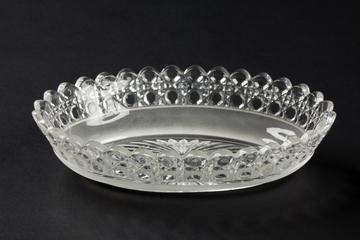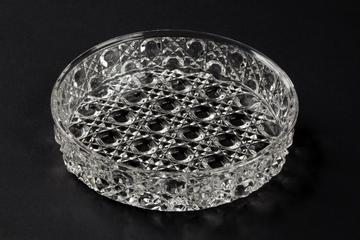
Glass tumbler with handle
- Made:
- 1878-03-01 in Ancoats




Glass tumbler with handle, Percival, Vickers & Co Ltd, registration diamond trade mark clockwise from top I W G 3, registered 01/03/1878, clear, repeat diamond design containing hexagon.
Pressed glass, once highly fashionable, made decorative glassware available to households for whom cut or blown glass was too expensive.
Manchester glass makers, including Percival Vickers, were some of the first companies to supply and popularise pressed glass in Britain. Percival Vickers were known for their innovative designs and excellent quality.
The pressed glass technique was developed in the early 1800s in the United States. Hot, molten glass was poured into a metal mould, known as a glass press, and pressure was applied. This partially mechanised the manufacturing process. Glass products could be formed with intricate shapes and patterns more reliably and in larger quantities. Before the invention of pressed glass, all decorative glass products were either cast then cut on a wheel by a craftsman or blown by a skilled glassblower. These premium, individually crafted products were expensive and only affordable to the very wealthy.
Percival, Vickers & Co Ltd was based in Flint Glass Works on Jersey Street in Ancoats, Manchester. The company was established in 1844 by Thomas Percival and William Yates. One of an important group of glassworks established in Manchester, during the mid to late 1800s, they employed as many as 370 workers. The company continued manufacturing up until 1914.
Details
- Category:
- Glass Industry
- Object Number:
- 2019-105
- Materials:
- glass
- Measurements:
-
overall: 61 mm x 116 mm x 68 mm,
- type:
- drinking glass




